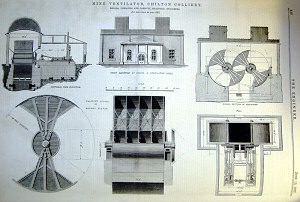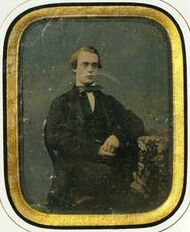Biography:Robinson Thwaites
Robinson Thwaites (1807 – 22 October 1884) was a nineteenth-century mechanical engineer and mill-owner in Bradford, Yorkshire. His companies included at different times Robinson Thwaites and Co, Thwaites and Carbutt and Thwaites Brothers.
Companies
Robinson Thwaites' father Thomas was a master plumber. Robinson trained as a plumber to follow in his father's business, and started to practice as a plumber.[1]
But instead, by 1848 he founded the Vulcan Iron Works at Bradford, as shown in an 1858 lithograph in the Illustrated Commerce Guide.[2] His firm, Robinson Thwaites and Co, later (1862) in partnership with Edward Carbutt as Thwaites and Carbutt, and (in 1880) Thwaites Brothers, acquired a high reputation for its machinery used in the production and manufacture of iron and Bessemer process steel.[3]
Robinson Thwaites and Co grew from a firm of "3 seniors, 50 men and 6 boys" in 1851 to "130 men and 13 boys" (as Thwaites and Carbutt) by 1871.[4] Thwaites Brothers continued in production until at least 1914.[5]
Products and patents
In 1862, Thwaites and Carbutt exhibited a selection of machine tools at the London Exhibition. These included a seven hundredweight double-action self-acting steam hammer; a four hundredweight double-action single standard hammer; a pillar radial drilling machine; a six-inch centre slide and screw cutting lathe; a "very powerful" planing machine; and a ten-inch centre double-geared slide lathe.[6]
In 1866, Thwaites and Carbutt Vulcan Works manufactured three locomotives "of 0-6-0 type" for Boulton.[7]
In 1869, Thwaites and Carbutt supplied the engines for a reversing rolling mill at Landore steel works.[8]
In 1877 Thwaites and Carbutt supplied a rolling mill engine (see illustration) for the Eston Ironworks of Bolckow Vaughan and Co. It had a 36-inch (91.44 cm) bore, and a 54-inch (137.16 cm) stroke.[9] That same year, the firm produced a coke crusher to prepare carbon for ironmaking.[10]
The pioneering engineering work of Thwaites and his partners is evident from the numerous patents they took out. One was for improvements to steam hammers.[11][12]
Another patent, taken out by Robinson's son William Henry Thwaites in 1877 with help from Edward Carbutt was for mine ventilation equipment, as installed at Chilton Colliery (see illustration).[13] The Roots ventilator had two 25 foot diameter rotary pistons, each 13 foot wide. They were driven by a steam engine whose cylinders had a 28-inch diameter and a 48-inch stroke.[9][14] The firm exhibited an "air blowing machine" at the St Petersburg Exhibition of New and Improved Mechanisms, Devices and Tools in 1875, alongside a similar one by Roots.[15]
In 1891, Scientific American published "illustrations of a Thwaites suspension pneumatic power 1/2 cwt. hammer of a new design, for planishing pipes and plates, for which we are indebted to Engineering [magazine]". The machine could deliver "500 blows per minute".[16]
In 1893, the foundry at the Consett Iron Works was using a Roots blower made by Thwaites Brothers.[17]
Family firm
Thwaites' work as a mechanical engineer was continued by three of his sons, Thomas Hirst Thwaites, Arthur Hirst Thwaites, and Edward Hirst Thwaites, all of whom became engineers in the firm.
A fourth son who also worked at the Vulcan Iron Works, William Henry Thwaites, married Mary Ann Stuttard of Colne, Lancashire on 23 October 1879,[18] but died in 1882 aged 32.
From being purely a family firm, Thwaites Brothers had a professional managing director by 1895, Arthur Devonshire Ellis.[19]
Thwaites Brothers were still in business as Engineers in 1914, continuing to make steam hammers, "Roots' blowers" (to ventilate mines) and assorted foundry equipment.[20]
Thwaites' eldest daughter, Mary Elizabeth Thwaites, married the Chief Clerk to Bow Street Magistrates' Court, John Alexander.
References
- ↑ 1841 Census, Public Record Office HO 107/1291/1 (Horton, Bradford)
- ↑ J. Currey, Illustrated Commerce Guide, 1858
- ↑ Institution of Mechanical Engineers: Biography of Edward Carbutt http://heritage.imeche.org/Biographies/EdwardCarbutt
- ↑ 1871 Census, Public Record Office RG 10/4478 (Horton, Bradford)
- ↑ Grace's Guide, Thwaites Brothers of Vulcan Works, Thornton Road, Bradford http://www.gracesguide.co.uk/wiki/Thwaites_Brothers
- ↑ "1862 London Exhibition: Catalogue: Class 7.: Thwaites and Carbutt". 1728. THWAITES and CARBUTT, Vulcan Iron Works, Bradford, Yorkshire.. Grace's Guide. 2007. http://www.gracesguide.co.uk/wiki/1862_London_Exhibition:_Catalogue:_Class_7.:_Thwaites_and_Carbutt. Retrieved 7 March 2012.
- ↑ Great Central Railway locomotives. Retrieved 1 April 2012. Note: The patent for the Cambrian system was granted to John Jones of Bristol in 1848, which is sometimes given as the date of manufacture, but the firm of Thwaites and Carbutt did not exist at that time.
- ↑ The Engineer, 29 October 1869, page 289.
- ↑ 9.0 9.1 Grace's Guide, Thwaites and Carbutt of Vulcan Works, Thornton Road, Bradford http://www.gracesguide.co.uk/wiki/Thwaites_and_Carbutt
- ↑ The Engineer, 9 March 1877, page 159.
- ↑ Graces's Guide, 1862 London Exhibition: Catalogue: Class 7: Thwaites and Carbutt http://www.gracesguide.co.uk/wiki/1862_London_Exhibition:_Catalogue:_Class_7.:_Thwaites_and_Carbutt
- ↑ The London Gazette, 11 June 1867 http://www.london-gazette.co.uk/issues/23262/pages/3322/page.pdf
- ↑ The London Gazette, 9 October 1877 http://www.london-gazette.co.uk/issues/24510/pages/5564/page.pdf
- ↑ The Engineer, 15 June 1877.
- ↑ Oil of Russia: New Technologies of "Steam Age". Archive No.4, 2005. Retrieved 1 April 2012.
- ↑ Scientific American Supplement, No. 799, April 25, 1891. Project Gutenberg (public domain).
- ↑ Jenkins, W. (2008). Consett Iron Works in 1893. Ad Publishing. p. 77. ISBN 9788792295002. https://books.google.com/books?id=PTYKSm2ouA0C&pg=PA77. Retrieved 2 April 2012.
- ↑ Lancashire OnLine Parish Clerk Project. Marriages at St Bartholomew in the Parish of Colne. 1879–1895. Retrieved 2 April 2012.
- ↑ "Proceedings of the Institution of Mechanical Engineers". Parts 3–4. Institution of Mechanical Engineers. 1896. https://archive.org/stream/p3p4proceedin1896inst/p3p4proceedin1896inst_djvu.txt. Retrieved 2 April 2012.
- ↑ Grace's Guide: Thwaites Brothers, sourced from 1914 Whitakers Red Book. Retrieved 1 April 2012.





